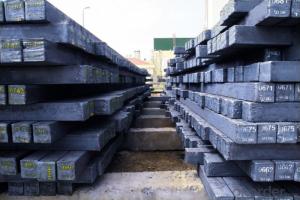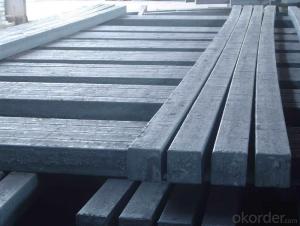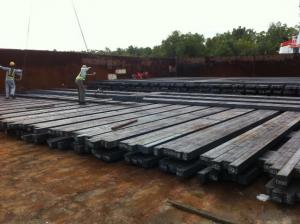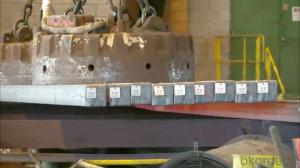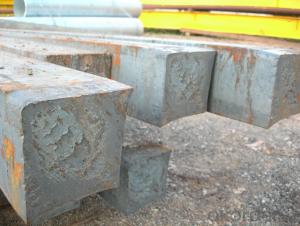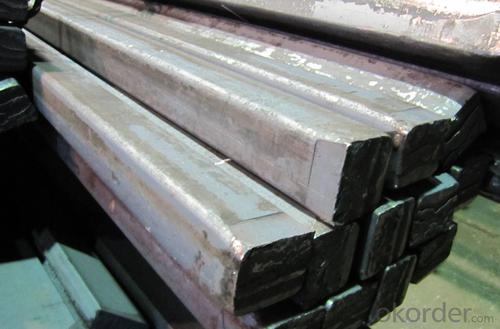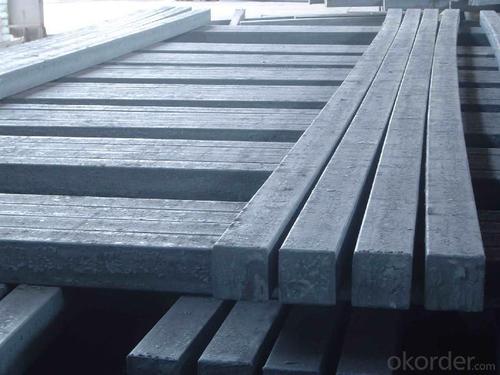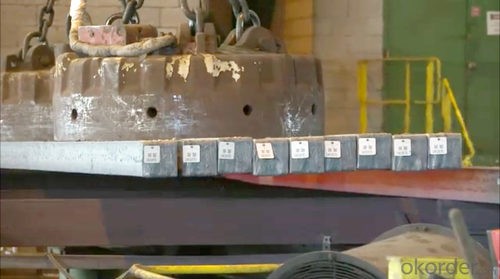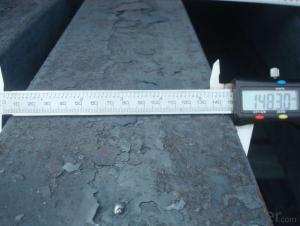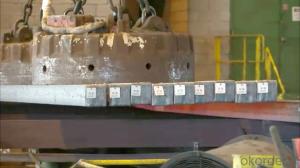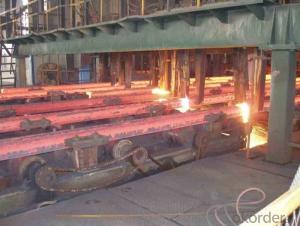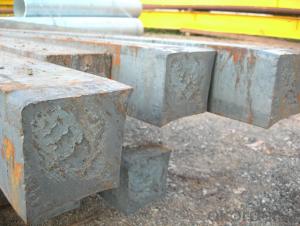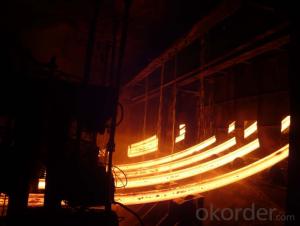Hot Rolled Square Steel Billet 3SP Standard 165mm
- Loading Port:
- Shanghai
- Payment Terms:
- TT OR LC
- Min Order Qty:
- 2000 m.t.
- Supply Capability:
- 10000 m.t./month
OKorder Service Pledge
OKorder Financial Service
You Might Also Like
Structure of Hot Rolled Square Steel Billet 3SP Standard 165mm
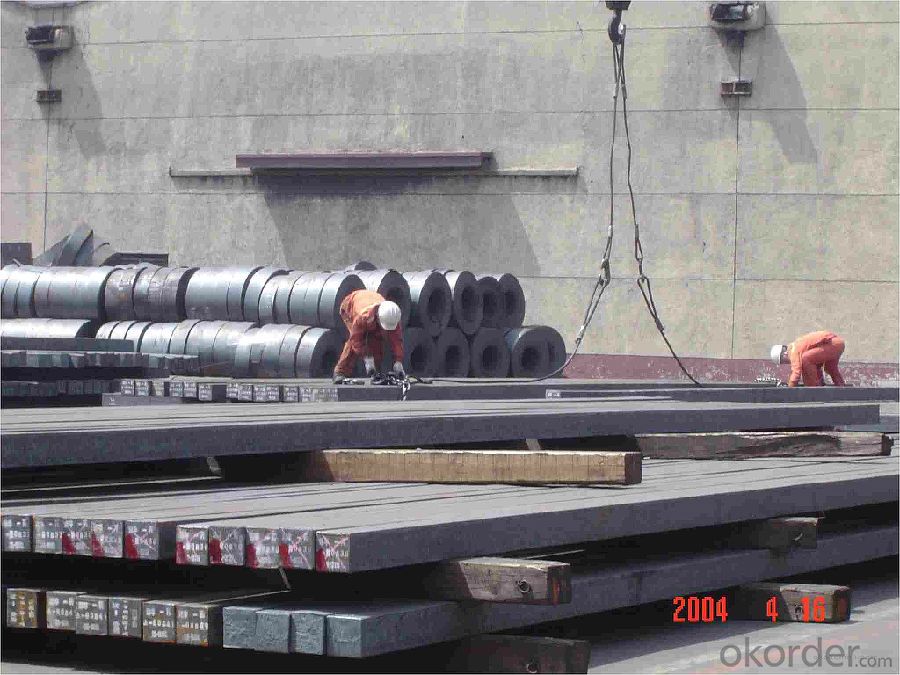
Description of Hot Rolled Square Steel Billet 3SP Standard 165mm
PPGI is made by cold rolled steel sheet and galvanized steel sheets as baseplate, through the surface pretreatment (degreasing, cleaning, chemical conversion processing), coated by the method of continuous coatings (roller coating method),
and after roasting and cooling. Zinc coating: Z60, Z80, Z100, Z120, Z180, Z275, G30, G60, G90
Alu-zinc coating: AZ60, AZ80, AZ100, AZ120, AZ180, G30, G60, G90
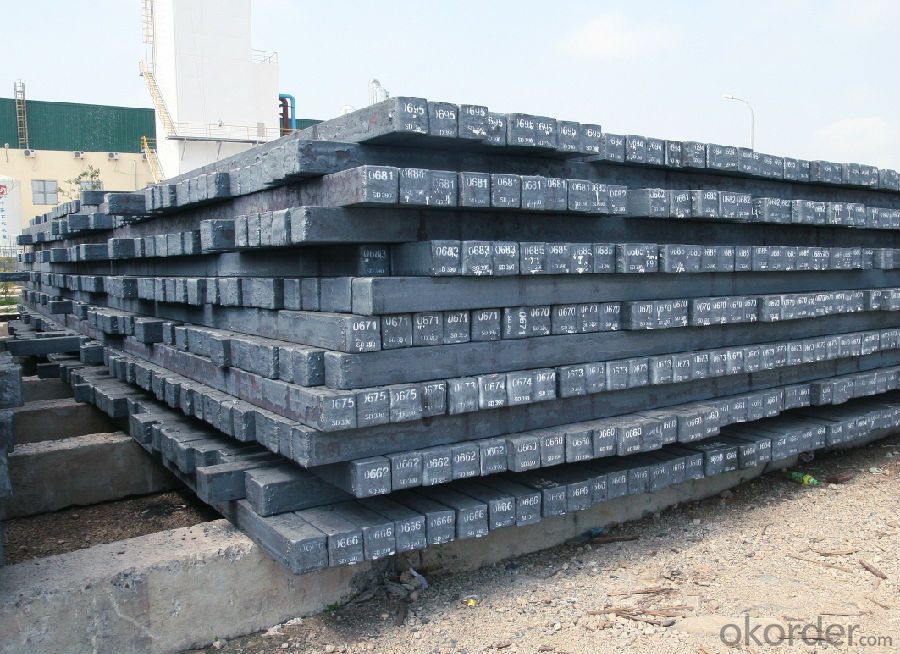
Main Feature of Hot Rolled Square Steel Billet 3SP Standard 165mm
1) Excellent corrosion resistance: The zinc layer provides a good protection of Pre-painted Galvanizeed Steel Sheet.
2) High heat resistance: The reflective surface of the material aids in efficiently reflecting the sunlight away and in turn reducing the amount of heat transmitted. The thermal reflectivity converts into energy savings.
3) Aesthetics: Pre-Painted Galvanized steel sheet is available in plethora of patterns and multiple sizes as per the requirements that given by our customers.
4) Versatility: can be used in the various areas.Standard seaworthy export packing: 3 layers of packing, inside is kraft paper, water plastic film is in the middle and outside GI steel sheet to be covered by steel strips with lock, with inner coil sleeve.
Applications of Hot Rolled Square Steel Billet 3SP Standard 165mm
1) Automotive bodies: filters, fuel tanks, etc.
2) Construction materials: roofings, welding pipes,
3) Electric and electronic appliances: computer cans, etc.
4) Steel cans: containers, etc.
5) Steel furniture: washing machines, refrigerators, microwaves, etc.
6) Drums
7) Office equipment: printer, recorders, etc.
8) Motors and transformers
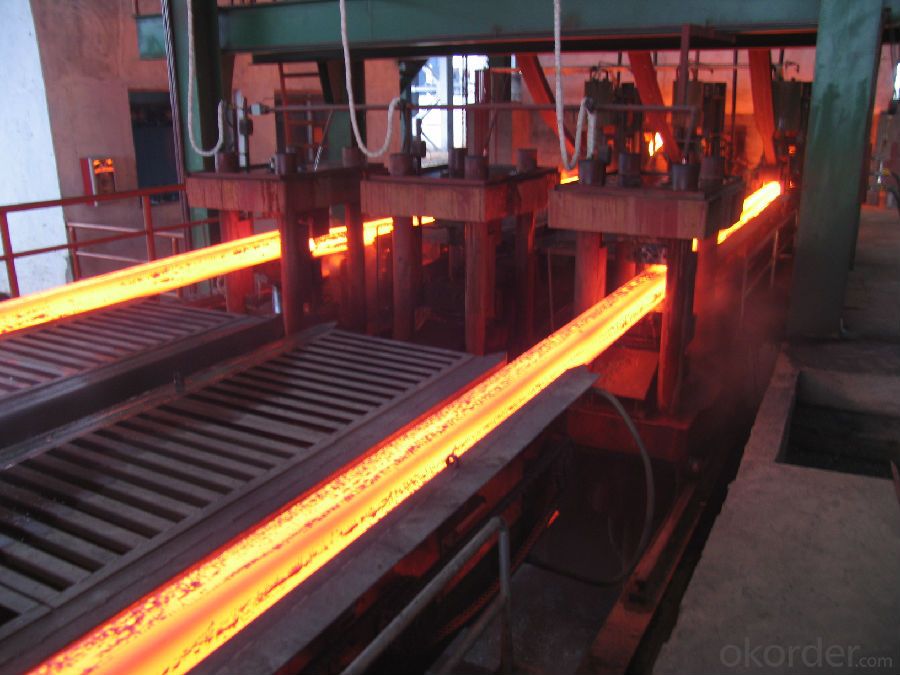
Specifications of Hot Rolled Square Steel Billet 3SP Standard 165mm
| Classified symbol | Yield Point Minimum N/mm2 | Tensile Strength Minimum | Elongation Minimum % | Application | ||||
| N/mm2 | Nominal Thickness mm (t) | |||||||
| JIS | Yogic | 0.25-0.4 | 0.4-0.6 | 0.6-1.0 | 1.0-1.6 | |||
| G3312 | specification | |||||||
| CGCC | CGCC | -205 | -270 | -20 | -21 | -24 | -24 | Commercial |
| CGCD | CGCD | --- | 270 | --- | 27 | 31 | 32 | Drawing |
| --- | CG340 | 245 | 340 | 20 | 20 | 20 | 20 | Structural |
| CGC400 | CG400 | 295 | 400 | 16 | 17 | 18 | 18 | Structural |
| CGC440 | CG440 | 335 | 440 | 14 | 15 | 16 | 18 | Structural |
| CGC490 | CG490 | 365 | 490 | 12 | 13 | 14 | 16 | Structural |
| CGC570 | CG570 | 560 | 570 | --- | --- | --- | --- | Structural |
| ASTM Designation | Yield Point Minimum | Tensile Strength Minimum | Elongation Minimum % | Application | Q/BQB 445-2004(China standard) | ASM A653/A653M | JISG 3312 | |
| ksi(MPa) | ksi(MPa) | TDC51D+Z | (CS TYPE A+Z) | CGCC | ||||
| A653(M)-99 CS TYPE A,B,C | --- | --- | --- | Commercial | TDC52D+Z | CGCD | ||
| A653(M)-99 FS | --- | --- | --- | Lock Forming | TS250GD+Z | (G250+Z) | - | |
| A653(M)-99 DS | --- | --- | --- | Drawing | TS300GS+Z | (G300+Z) | CGC 400 | |
| A653(M)-99 SS Grade33(230) | 33(230) | 45(310) | 20 | Structural | TS350GD+Z | (G350+Z) | CGC490 | |
| A653(M)-99 SS Grade37(255) | 37(255) | 52(360) | 18 | Structural | TS550GD+Z | (G550+Z) | CGC570 | |
| A653(M)-99 SS Grade40(275) | 40(275) | 55(380) | 16 | Structural | ||||
| A653(M)-99 SS Grade50(345) | 50(345) | 65(450) | 12 | Structural | ||||
| A653(M)-99 SS Grade80(550) | 80(550) | 82(570) | --- | Structural | ||||
FAQ of Hot Rolled Square Steel Billet 3SP Standard 165mm
We have organized several common questions for our clients,may help you sincerely:
1. How Can I Visit There?
Our company is located in Tianjin City, China, near Beijing. You can fly to Tianjin Airport Directly. All our clients, from home or aboard, are warmly welcome to visit us!
2. How Can I Get Some Sample?
We are honored to offer you sample.
3. Why choose CNBM?
1, ISO, BV, CE, SGS approved.
2, Competitive price and quality.
3, Efficient service team online for 24 hours.
4, Smooth production ability(50000tons/month) .
5, quick delivery and standard exporting package.
6, Flexible payment with T/T, L/C, Paypal, Kunlun bank, etc.
- Q: What is the difference between steel billets and steel ingots?
- Steel billets and steel ingots, although both semi-finished steel products, differ in terms of their shape and manufacturing process. Rectangular or square-shaped bars, steel billets are typically produced through a continuous casting process. This process involves pouring molten steel into molds, allowing it to solidify into the desired shape. Billets are commonly used as raw material for further processing, such as rolling or forging, to create finished steel products like bars, rods, or wire. On the contrary, steel ingots are large, solid blocks of steel that are usually produced through a traditional casting process. In this process, molten steel is poured into large molds, left to cool and solidify. Ingots are mainly used for the production of larger steel components or as feedstock for forging or rolling operations. Prior to being processed into the final product, they are often remelted and refined. In terms of size, billets are generally smaller, with a cross-sectional area ranging from 36 to 155 square inches. On the other hand, ingots are larger, with a cross-sectional area exceeding 155 square inches. Both steel billets and steel ingots act as intermediary products in the steel manufacturing industry. The decision to use billets or ingots depends on the specific requirements of the final steel product and the manufacturing process involved.
- Q: How are steel billets used in the manufacturing of valves and fittings?
- Valves and fittings rely on steel billets, an essential raw material, for their production. These billets are solid steel forms, cast into specific shapes and sizes. The manufacturing process starts by heating the steel billets to a high temperature and passing them through rolling mills to achieve the desired form. This process refines the grain structure, enhancing the steel's strength, ductility, and overall quality. After shaping, the billets undergo further processing and machining to create various valve and fitting components, including bodies, bonnets, stems, and other essential parts. Precise machining ensures accurate dimensions and smooth surfaces, enabling proper assembly and functioning. Steel billets also provide crucial strength and durability to valves and fittings, as they are made from high-quality steel. This ensures that the final products can withstand the harsh operating conditions, pressure, and temperature variations they may encounter. Moreover, steel billets offer versatility in manufacturing, allowing the production of different types of valves and fittings, such as gate valves, ball valves, butterfly valves, and pipe fittings. This flexibility enables manufacturers to meet diverse industry requirements. In summary, steel billets serve as the primary raw material in the production of valves and fittings. Shaping, processing, and machining these billets result in high-quality components that offer strength, durability, and precision in the final products.
- Q: What are the different types of steel billet surface treatments?
- There are several different types of steel billet surface treatments, including pickling, shot blasting, and painting. Pickling involves removing impurities and oxides from the surface of the billet using an acid solution. Shot blasting is a process in which small metallic or abrasive particles are blasted onto the surface of the billet to remove rust, scale, and other contaminants. Painting involves applying a protective coating or layer of paint to the surface of the billet to prevent corrosion and improve its appearance.
- Q: How are steel billets used in the manufacturing of packaging equipment?
- Steel billets are used in the manufacturing of packaging equipment as they serve as the raw material for various components and parts. These billets are melted down and shaped into the desired form, such as plates, bars, or tubes, which are then further processed to create the structural framework, frames, or supports required for packaging machinery. The strength, durability, and malleability of steel make it an ideal choice for constructing robust and reliable packaging equipment, ensuring efficient and safe packaging operations.
- Q: What are the different types of steel billets used in the manufacturing industry?
- There are several different types of steel billets used in the manufacturing industry, each with its own unique properties and qualities. Some of the most common types include: 1. Carbon Steel Billets: These are the most widely used type of steel billets and are made primarily from iron and carbon. They are known for their high strength and durability and are used in a variety of applications, including construction, automotive, and machinery manufacturing. 2. Alloy Steel Billets: Alloy steel billets are made by adding various alloying elements to carbon steel, such as manganese, nickel, chromium, and molybdenum. This results in improved properties such as increased strength, hardness, and resistance to corrosion. They are often used in the production of high-strength components and machinery parts. 3. Stainless Steel Billets: Stainless steel billets are made from iron, chromium, and other alloying elements, such as nickel and molybdenum. They are highly resistant to corrosion and staining and are commonly used in the manufacturing of kitchen appliances, automotive parts, and medical equipment. 4. Tool Steel Billets: Tool steel billets are specifically designed for use in the production of tools, dies, and molds. They have high hardness, wear resistance, and toughness, making them ideal for applications that require cutting, shaping, or molding materials. 5. Micro-Alloyed Steel Billets: These billets contain small amounts of alloying elements, such as vanadium, niobium, or titanium. They are used to improve the strength and toughness of the steel, making them suitable for structural applications in industries such as construction and transportation. It's important to note that these are just a few examples of the different types of steel billets used in the manufacturing industry. There are many other specialized types available, each tailored to meet specific requirements for different applications and industries.
- Q: Can steel billets be used in the production of appliances?
- Appliances can indeed utilize steel billets for their production. These semi-finished products are typically employed for subsequent processing into diverse forms and dimensions. In the context of appliances, steel billets can serve as the primary material for fabricating elements like frames, panels, and other structural components. Steel possesses remarkable versatility and durability, providing robustness, stability, and corrosion resistance, thereby rendering it appropriate for appliances requiring sturdy construction. Moreover, steel can be effortlessly molded and shaped to fulfill the distinct design requisites of various appliances, making it the preferred choice in the manufacturing procedure.
- Q: Are steel billets susceptible to corrosion?
- Steel billets can be affected by corrosion. Steel, which is mostly made up of iron and carbon, is prone to corrosion because of the presence of iron. When exposed to moisture and oxygen, a chemical reaction occurs on the surface of the steel, resulting in the formation of rust, also known as iron oxide. This corrosion weakens the structure of the steel and can eventually cause it to fail. To prevent corrosion, protective layers are often applied or anti-corrosion agents are used on steel billets. Common methods include galvanizing, where a layer of zinc is added, or coating the steel with paint or epoxy. Additionally, storing steel billets in dry environments and ensuring proper ventilation can help reduce the risk of corrosion. It's worth noting that the susceptibility to corrosion can also depend on the specific composition and grade of the steel used in the billets. Certain types of stainless steel, for example, contain additional elements such as chromium and nickel, which offer improved resistance to corrosion. However, even stainless steel can corrode under certain conditions, although at a slower rate compared to regular carbon steel. Regular inspection, maintenance, and appropriate corrosion prevention measures are essential in ensuring the long-lasting durability of steel billets.
- Q: How are steel billets used in the production of oil and gas exploration equipment?
- Steel billets are commonly used in the production of oil and gas exploration equipment due to their strength and durability. These billets are shaped and machined into various components such as valves, pumps, drilling tools, and pipelines, which are crucial for the extraction and transportation of oil and gas. The high-quality steel ensures that the equipment can withstand harsh operating conditions, including high temperatures, pressure, and corrosive environments, thereby ensuring the safety and reliability of oil and gas exploration operations.
- Q: How are steel billets used in the production of gear blanks?
- Gear blanks are made from steel billets, which are essential for their production. Steel billets are long bars of steel that possess the necessary characteristics for gear manufacturing. These billets are made from high-quality steel and provide the material needed for creating gear blanks. To shape the gear blanks, the steel billets are heated to a specific temperature, making them easier to work with. Various forming processes, such as forging or extrusion, are then used to transform the billets into the desired shape of the gear blank. Once the gear blank is formed, it undergoes further machining processes to refine its shape, dimensions, and surface finish. This includes turning, milling, drilling, or grinding operations. Precise machining is necessary to meet the required specifications for the final gear product. The gear blanks produced from steel billets are the foundation for creating different types of gears, including spur gears, helical gears, bevel gears, or worm gears. These gear blanks undergo additional steps, such as heat treatment and surface hardening, to enhance their mechanical properties and increase their resistance to wear and fatigue. In conclusion, steel billets are crucial in the production of gear blanks as they provide the raw material for creating gears. Through heating, forming, and machining processes, the steel billets are transformed into gear blanks, which are then further processed to create the final gears used in various applications.
- Q: What are the main factors affecting the magnetic properties of steel billets?
- The main factors affecting the magnetic properties of steel billets are composition, microstructure, and processing conditions. Firstly, the composition of the steel billet plays a significant role in its magnetic properties. The presence of certain alloying elements, such as nickel, cobalt, and manganese, can enhance the magnetic properties of steel. These elements align the magnetic domains within the steel, resulting in increased magnetization and improved magnetic properties. Secondly, the microstructure of the steel billet affects its magnetic properties. The grain size, crystal structure, and presence of defects or impurities can influence the magnetic behavior of the material. Finer grain sizes tend to have better magnetic properties due to improved alignment of the magnetic domains. Additionally, a single-phase crystal structure is generally more magnetic than a multi-phase structure. Lastly, the processing conditions during the production of steel billets can impact their magnetic properties. Factors such as temperature, cooling rate, and mechanical deformation can affect the microstructure and, consequently, the magnetic behavior. For example, rapid cooling can result in a finer grain size and better magnetic properties, while mechanical deformation can induce magnetic anisotropy, making the steel more magnetically oriented along a specific direction. In summary, the magnetic properties of steel billets are mainly influenced by the composition, microstructure, and processing conditions. By controlling these factors, manufacturers can tailor the magnetic properties of steel billets to meet specific requirements for various applications, such as in electrical transformers, motors, or magnetic sensors.
Send your message to us
Hot Rolled Square Steel Billet 3SP Standard 165mm
- Loading Port:
- Shanghai
- Payment Terms:
- TT OR LC
- Min Order Qty:
- 2000 m.t.
- Supply Capability:
- 10000 m.t./month
OKorder Service Pledge
OKorder Financial Service
Similar products
Hot products
Hot Searches
Related keywords
